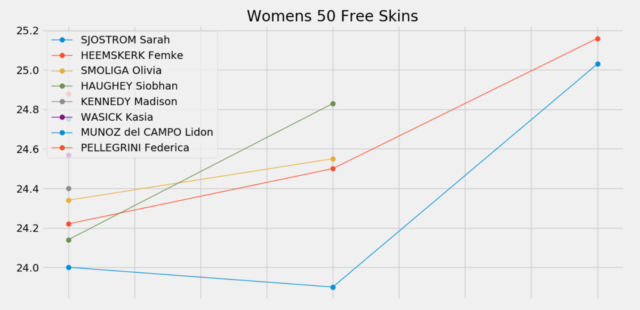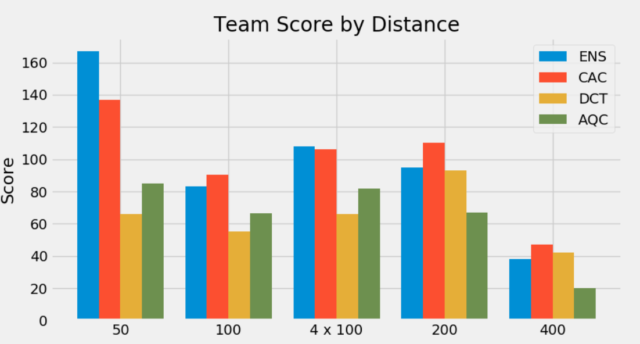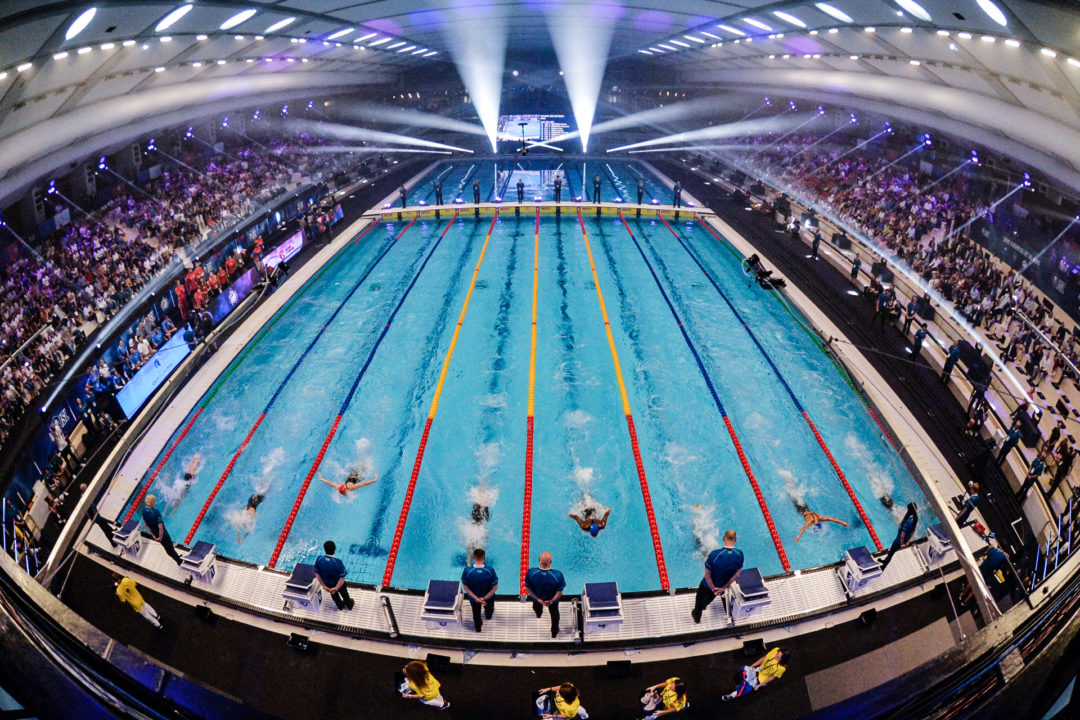With the second ISL meet in Naples all wrapped up, I thought we’d return to some of the numbers I showed last week and see how Naples compared to Indianapolis. Did teams use their swimmers more or less? Were there more or fewer turnarounds? Did you SEE those skins races?!
MULTIPLE EVENTS
Let’s start with event counts. In Indy, Sarah Sjostrom and Olivia Smoliga topped the list at seven swims each. In Naples, two athletes swum eight events: Cali Condors’ Caeleb Dressel and DC Trident’s Siobhán Haughey. Three other swimmers competed in seven events:
– Chad le Clos, ENS
– Olivia Smoliga, CAC
– Kregor Zirk, ENS
And three more competed in six:
– Bethany Galat, DCT
– Federica Pellegrini, AQC
– Sarah Sjostrom, ENS
Putting both meets together, Smoliga and Haughey lead the ranks with fourteen swims between the two competitions, with Sjostrom, le Clos, and Zirk right behind them with thirteen swims.
The Aqua Centurions are generally more distributed – Santo Condorelli leads them 11 swims and only two others even have as many as 10. All the other teams have six swimmers with at least 10 swims.
KILOMETER CLUB
In Indy, the kilometer club had 6 entrants, led by Energy Standard’s Mary-Sophie Harvey who covered 1400m. In Naples, the kilometer club increased to 9 entrants:
– Melanie Margalis, CAC: 1200m (200/400 IM, 400 Free, two relays)
– Bethany Galat, DCT: 1200m (200/400 IM, 100/200 Breast, 200 Fly, one relay)
– Mary-Sophie Harvey, ENS: 1200m (200 Back, 200 Fly, 400 Free, 400 IM)
– Emma Barksdale, DCT: 1200m (200 Breast, 200 IM, 400 Free, 400 IM)
– Kregor Zirk, ENS: 1150m (50/100/200 Back, 100/200 Fly, 400 Free, one relay)
– Mark Szaranek, CAC: 1100m (200 Fly, 400 Free, 400 IM, one relay)
– Megan Kingsley, CAC: 1000m (200 Back, 200 Fly, 200/400 IM)
– Hannah Miley, AQC: 1000m (200/400 IM, 400 Free)
– Anton Ipson, CAC: 1000m (200/400 Free, 400 IM)
Across both meets, we now have five members of the TWO kilometer club: Harvey (2600m), Zirk (2250m), and Margalis, Barksdale, and Szaranek all at 2000m.
TURNAROUND TIMES
The shortest Indianapolis turnaround time was a mere five minutes for Bethany Galat of DC Trident between her 100 Fly and 50 Breast. She got a lot more reset in Naples, her shortest gap between events was just about 19 minutes between the medley relay and her 200 IM. Which by ISL standards is a pretty healthy gap.
In Naples, the honor for shortest turnaround goes to… Cali Condors’ Caeleb Dressel, with just a 7:28 gap between his 50 free and swimming the fly leg of the mens medley relay.
The other gaps below 15 minutes were:
– Zach Apple (DCT): ~8:19 between his 50 free and the medley relay (he swam the freestyle leg, so slightly more rest than Dressel)
– Natalie Hinds (CAC): ~10:21 between the 50 fly and the mixed free relay
– Silvia di Pietro (AQC): ~11:09 between the same events (except a later leg)
– Melanie Margalis (CAC): ~11:15 between the 400 IM and the free relay
– Justin Ress (CAC): ~12:36 between the 50 fly and the mixed free relay
– Mitch Larkin (CAC): ~13:06 between the 200 IM and the 100 Back
– Mitch Larkin (CAC), Andreas Vazaios (DCT), Travis Mahoney (AQC), Radoslaw Kawecki (CAC), and Evgeny Rylov (ENS): ~13:07-13:10 between the 200 Back and the medley relay
– Kregor Zirk (ENS): ~14:42 between the same two events, but he did a later leg
Some of these gaps are just facts of the schedule: five of the eight mens’ 200 backstrokers came back to just 13 minutes later to swim the backstroke leg on their medley relays.
SKINS RACES
Alright, now the fun and ridiculous part. Last week, the smallest gap from between rounds was shared at a 1.8% gain from round 1 to round 2 (by both Sjostrom and Smoliga). The smallest gap amongst the men was Manaudou’s 3.6% gain. How do those times compare to Naples? Night and Day.
Here are the sorted gains from round to round in Naples:
* -0.4% (Sjostrom from 1-2)
* 0.1% (Dressel from 2-3)
* 0.9% (Smoliga from 1-2)
* 1.2% (Heemskerk and Dressel from 1-2)
* 2.5% (Manaudou from 1-2)
* 2.7% (Heemskerk from 2-3)
* 2.9% (Haughey from 1-2)
* 3.3% (Proud from 1-2)
* 4.7% (Sjostrom from 2-3)
* 5.5% (Gkolomeev from 1-2)
* 6.2% (Manaudou from 2-3)
To start with, Sjostrom actually went FASTER on the 2nd round (23.90) than she did on the first (24.00). Smoliga improved her gap pretty dramatically with the new strategy that she was discussing (only 0.9% slower, though she very nearly didn’t make it to the second round). Manaudou also improved here – he was 3.6% slower last week, but only 2.5% slower this time around.

And then Dressel just goes ahead and swims the same time for the second and the third race, which is just something else – while everyone else went at least 2.7% slower. Manaudou predicted Dressel would win the skins. I can’t wait to see if anybody’s going to top THAT performance. And keep in mind that Dressel’s 2nd and 3rd swims beat every other time except his own and Manaudou’s 1st time (and only barely behind Florent).

BREAKDOWN BY DISTANCES

In Indy, we saw the DC Trident as a distance-oriented team, winning three out of the four 400m events. In Naples, they continued that trend, faring very well at races 200m and longer.
Whereas in Indy, Energy dominated the 50s (+21.5 over Cali), 100s (+15.5), and relays (+28), the story in Naples was much more even. Energy dominated the 50s (+30 over Cali), but was actually outscored in the 100s (-7.5) and was very close in the relays (+2, due to their DQ).

Great stuff